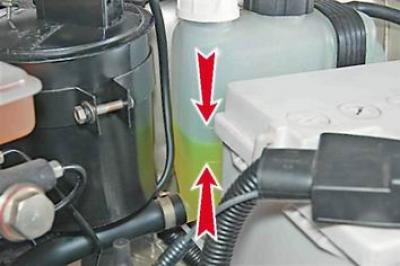Execution sequence
1. We prepare the car for work (see "Preparing the car for maintenance and repair").
Warning! The coolant level should be checked on a cold engine. A slight increase or decrease in the coolant level when the engine warms up and cools down is not a malfunction. This is due to the thermal change in the volume of the liquid.
2. Check the coolant level in the expansion tank, which should be 25-30 mm above the mark "MIN", made on the body of the expansion tank. If the fluid level is at "MIN" or lower, add coolant to the reservoir (see "Coolant - replacement").

Recommendation: If you have to top up the coolant regularly, you should check the tightness of the cooling system.
3. We check the absence of fluid leaks from the drain holes of the radiator and the engine block, the installation locations of the temperature sensors, the connections of the rubber hoses of the cooling system and their integrity.
Recommendation: Coolant leakage from under the hoses can be eliminated by tightening the hose clamps. Do not overtighten the clamps, as they may cut the hoses.
4. We check the integrity of the body of the expansion tank, engine radiator and heater.
5. We are convinced of the tightness of the thermostat housing, as well as the connection of the coolant pump and the cylinder block.
6. Check for fluid leakage from the pump drain (located at the bottom of the pump), indicating the wear of its gland.
7. To check the thermostat, start a cold engine. We control the temperature of the coolant according to the indicator on the instrument panel, and the circulation of the liquid in a small and large circle - by touch, by changing the temperature of the hoses and pipes of the cooling system.
Note: If the engine cooling system is in good order, then when the coolant temperature is less than 90°C, the main thermostat valve should be closed, and the coolant should circulate in a small circle. As a result, the lower radiator hose and the radiator itself will be noticeably colder than the thermostat housing, through which hot coolant circulates. When the coolant temperature reaches about 90°C, the main thermostat valve will open and a gradually increasing flow of hot liquid will begin to flow into the radiator. In this case, first the radiator, and then its lower hose, will begin to heat up.
When the temperature reaches 102°C, the main thermostat valve will fully open and the entire fluid flow will circulate through the radiator. In this case, the radiator will become hot in the upper zone and slightly colder in the lower zone.
8. Leave the engine running until the engine radiator fan is activated. When the temperature of the coolant rises to a value when the arrow of the temperature gauge approaches the border of the red zone, the electric fan should turn on, and after the temperature drops, it should turn off automatically.
Recommendation: If the electric fan did not turn on in time, the liquid boiled, it is necessary to check the serviceability of the engine control system or the serviceability of the fan motor.
Note: Checking the coolant temperature gauge sensor is shown in the section "Temperature gauge sensor - check and replacement".
